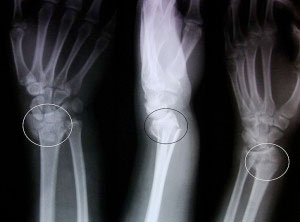Why the wrist is at risk in winter sports
Now that winter is fully upon us, it’s time to dust off our skis, snowboards, and ice skates and bundle up for some winter fun! As you’re preparing for your winter escape, remember that you’ll be walking on thin ice if you don’t prepare for your excursion with safety in mind!
 Different winter activities have different risks associated with them. In skiing, knee injuries are the most common occurrence, while in snowboarding the most common injuries are to the upper extremities since both feet are attached to the board. More specifically, wrist fractures are the most common snowboarding injuries. The wrist is also at risk in ice-skating or even if you just happen to slip and fall while walking on an icy sidewalk. Let’s look at the various types of wrist injuries in a little more depth.
Different winter activities have different risks associated with them. In skiing, knee injuries are the most common occurrence, while in snowboarding the most common injuries are to the upper extremities since both feet are attached to the board. More specifically, wrist fractures are the most common snowboarding injuries. The wrist is also at risk in ice-skating or even if you just happen to slip and fall while walking on an icy sidewalk. Let’s look at the various types of wrist injuries in a little more depth.
Wrist fractures most commonly occur when someone falls on outstretched hands and the impact pushes the hand backwards. A wrist fracture can be a break in any of the numerous wrist bones or the ends of either of the two bones of the forearm. The scaphoid is the smallest wrist bone and one of the easiest bones to break. The forearm is made up of two main bones, the radius, which connects from the thumb side of the hand to the elbow, and the ulna, which is larger and longer and runs parallel to the radius. A particularly common wrist fracture is called a Colle’s Fracture, and this occurs when the radius is fractured near its connection to the hand.
So, how do you know whether or not you’ve broken your wrist? Some common signs to look out for after a fall are the following: Immediate pain, swelling through the hand or forearm, tenderness, difficulty moving the wrist, and just the wrist “not looking quite right.” If it seems that your wrist is stuck in a weird position or if you see a bulge that is not normal, then it is highly possible that you have fractured your wrist.
If you or someone in your group do suffer a wrist injury, there are a few things you can do to ease the discomfort – especially since the nearest medical center can be a few hours away! You can give the injured person ibuprofen (Advil or Motrin) to help relieve some of the pain and reduce the swelling. Also, if you have access to a splint, you can carefully splint the wrist. A Sam Splint may be found in some first aid kits or you can make an improvised splint out of something like a ski poles tied together. If you can’t splint the wrist without causing too much pain, then try to find some position that will keep the wrist relatively still and stable. Applying ice can also be useful to reduce the swelling. Once you get to the nearest medical facility a doctor will be able to determine what type of treatment, typically either a cast or surgery, will be best for the particular injury.
Hopefully, with a few easy safety preparations you can keep your winter vacation free of emergency room visits! The most important thing to remember when preparing for any sport or wilderness activity is to make sure to protect yourself as well as possible. Always wear a helmet when skiing or snowboarding (or if you’re just learning to ice skate and you want to avoid a painful headache!). It’s also a good idea to wear kneepads under your snow pants and wrist guards under your gloves to protect you against the most common winter sports injuries. Always make sure that someone in your group has a kit with basic first aid gear. Even without a major mishap, active sports like skiing, snowboarding, and ice skating can leave your muscles pretty sore. Taking some ibuprofen can help with the general aches and pains of a fun day on the slopes and also come in handy if there were any unexpected falls!
So, before the snow melts, get in all the snowboarding, ice-skating, skiing, snowball fights and sledding you can. Make sure to take precautions, though, so you don’t have to cut your fun short by having an unexpected slip on some ice!
Leave a Comment